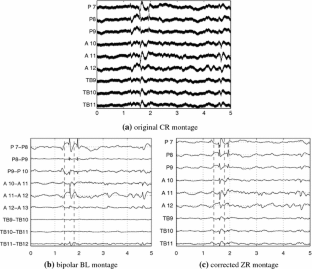Abstract
The starting point of this paper is the analysis of the reference problem in intra-cerebral electroencephalographic (iEEG) recordings. It is well accepted that both surface and depth EEG signals are always recorded with respect to some unknown time-varying signal called reference. This article discusses different methods for determining and reducing the influence of the reference signal for the iEEG signals. In particular, we derive optimal approaches for the estimation of the reference signal in iEEG recording setups and demonstrate their relation to the well-known minimum power/variance distortionless response approaches derived for general array and antenna signal processing applications. We show that the proposed approaches achieve optimal performance in terms of estimation error and that they outperform other reference identification methods proposed in the literature. The developed algorithms are illustrated on simulated examples and on real iEEG signals.








Similar content being viewed by others
Notes
Average or Laplacian references are never used for depth EEG signals. In fact, electrode placement is not symmetric, so there is no reason to suppose that signals should average to 0 as in scalp recordings.
Hu et al. [7] proposed an alternative method replacing the FastICA step by simple principal component analysis, thus not imposing statistical independence but only decorrelation.
Another ambiguity relates to the order of the sources, which is also impossible to recover.
The BSS estimate \(\hat{r}_{\rm BSS}\) was selected, among all sources found by BSS, as the signal having the highest absolute value of the correlation coefficient with the original signal \(r.\)
Still, other BSS algorithms, based on second-order statistics only (SOBI for example) will function also for Gaussian sources.
More specific studies using connectivity measures will be described elsewhere.
References
Dien J (1998) Issues in the application of the average reference: review, critiques and recommendations. Behav Res Methods Instrum Comp 30(1):34–43
Essl M, Rappelsberger P (1998) EEG coherence and reference signals: experimental results and mathematical explanations. Med Biol Eng Comput 39:399–406
Hjorth B (1975) An on-line transformation of EEG scalp potentials into orthogonal source derivations. Electroencephalogr Clin Neurophysiol 39(5):526–530
Hu S, Stead M, Dai Q, Worrell G (2010) On the recording reference contribution to EEG correlation, phase synchrony, and coherence. IEEE Trans Syst Man Cybern Part B Cybern 40(5):1294–1304
Hu S, Stead M, Gardner AB, Worrell GA (2007) Lecture notes in computer science: advances in neural networks. In: The effect of recording reference on EEG: phase synchrony and coherence. Springer, Berlin, pp 1273–1280
Hu S, Stead M, Worrel G (2007) Automatic identification and removal of scalp reference signal for intracranial EEGs based on independent component analysis. IEEE Trans Biomed Eng 54(9):1560–1572
Hu S, Stead M, Worrell G (2008) Removal of scalp reference signal and line noise for intracranial EEGs. In: IEEE international conference on networking, sensing and control, 2008. ICNSC 2008, pp 1486–1491
Hyvärinen A (1999) Fast and robust fixed-point algorithms for independent component analysis. IEEE Trans Neural Netw 10(3):626–634
Koessler L, Salido-Ruiz R, Ranta R, Louis-Dorr V, Gavaret M, Maillard L (2010) Influence of source separation and montage on ictal source localization. In: Engineering in Medicine and Biology Society (EMBC), 2010 Annual international conference of the IEEE, pp 2898–2901. doi:10.1109/IEMBS.2010.5626321
Maillard L, Koessler L, Colnat-Coulbois S, Vignal J, Louis-Dorr V, Marie P, Vespignani H (2009) Combined SEEG and source localisation study of temporal lobe schizencephaly and polymicrogyria. Clin Neurophysiol 120:1628–1636
Pascual-Marqui RD (2007) Discrete, 3D distributed, linear imaging methods of electric neuronal activity. Part 1: exact, zero error localization. Tech. rep., The KEY Institute for Brain-Mind Research University Hospital of Psychiatry, Lenggstr. 31, CH-8032 Zurich, Switzerland. http://arxiv.org/abs/0710.3341
Ranta R, Madhu N (2012) Reference estimation in EEG: analysis of equivalent approaches. IEEE Signal Process Lett 19:12–15
Ranta R, Salido-Ruiz R, Louis-Dorr V (2010) Reference estimation in EEG recordings. In: 32nd Annual international conference of the IEEE-EMBS. Buenos Aires, Argentina
Salido-Ruiz R, Ranta R, Louis-Dorr V (2011) EEG montage analysis in the blind source separation framework. Biomed Signal Process Control 6(1):77–84
Sanei S, Chambers J (2007) EEG signal processing. Wiley, New York
Strang G (1988) Linear algebra and its applications, 3 edn. Thomson/Brooks Cole, California
van Trees HL (2002) Detection, estimation and modulation theory: part IV. Wiley, New York
Woodbury MA (1950) Inverting modified matrices. Tech. Rep. Memorandum Rept. 42, Statistical Research Group, Princeton University
Yao D (2001) A method to standardize a reference of scalp EEG recordings to a point at infinity. Physiol Meas 22:693–711
Acknowledgments
Nilesh Madhu has been supported under the framework of ITN-AUDIS, Digital Signal Processing in Audiology (http://www.audis-itn.eu), funded by the European Union under the Framework 7 People Marie-Curie Programme. This research was partially funded by the Neuro-IC programm of CNRS, France. The authors would like to thank Dr. S. Colnat-Coulbois for her neurosurgical contribution.
Author information
Authors and Affiliations
Corresponding author
Rights and permissions
About this article
Cite this article
Madhu, N., Ranta, R., Maillard, L. et al. A unified treatment of the reference estimation problem in depth EEG recordings. Med Biol Eng Comput 50, 1003–1015 (2012). https://doi.org/10.1007/s11517-012-0946-0
Received:
Accepted:
Published:
Issue Date:
DOI: https://doi.org/10.1007/s11517-012-0946-0

